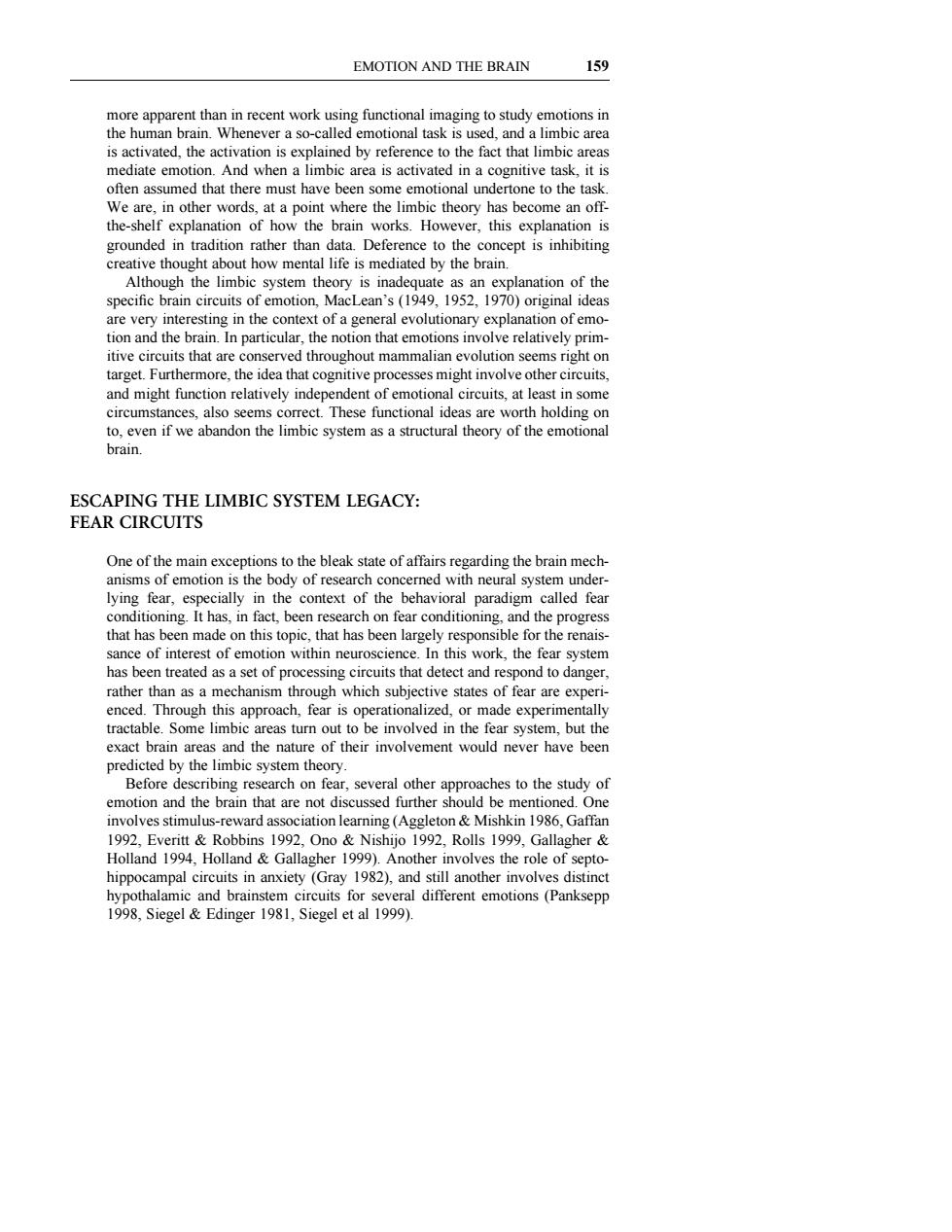正在加载图片...

EMOTION AND THE BRAIN 159 more apparent than in recent work using functional imaging to study emotions in ma a so-cal mediate emotion.And when a limbic area is activated in a cognitive task.it is often assumed that there must have been some emotional undertone to the task ounded in tradition rather than ta.Deference to th thouht about howmtasdbythe cept is inhibiting specific b an origina tion and the brain.In particular.the notion that emotions involve relatively prim- cognitive proces s might involve to,even if we abandon the limbic system as a structural theory of the emotional brain. ESCAPING THE LIMBIC SYSTEM LEGACY: FEAR CIRCUITS lying fear,especially in the context of the behavioral paradigm called fear as,in act,been tha earch on fear conditionng and as been largery the progress ork,the ren has been treated as a set of processing circuits that detect and respond to danger rather than as a mechanism through which subjective states of fear are experi enced Through sapproach,ear or made experimentall predicted by the limbic system theory. earch on fe r,several other approaches to the study of emotion and d a t are 1992.Everitt&Robbins 1992.Ono&Nishijo 1992.Rolls 1999,Gallagher& Holland 1994,Holland&Gallagher 1999).Another involves the role of septo- nxiety(Gray).and st I another EMOTION AND THE BRAIN 159 more apparent than in recent work using functional imaging to study emotions in the human brain. Whenever a so-called emotional task is used, and a limbic area is activated, the activation is explained by reference to the fact that limbic areas mediate emotion. And when a limbic area is activated in a cognitive task, it is often assumed that there must have been some emotional undertone to the task. We are, in other words, at a point where the limbic theory has become an offthe-shelf explanation of how the brain works. However, this explanation is grounded in tradition rather than data. Deference to the concept is inhibiting creative thought about how mental life is mediated by the brain. Although the limbic system theory is inadequate as an explanation of the specific brain circuits of emotion, MacLean’s (1949, 1952, 1970) original ideas are very interesting in the context of a general evolutionary explanation of emotion and the brain. In particular, the notion that emotions involve relatively primitive circuits that are conserved throughout mammalian evolution seems right on target. Furthermore, the idea that cognitive processes might involve other circuits, and might function relatively independent of emotional circuits, at least in some circumstances, also seems correct. These functional ideas are worth holding on to, even if we abandon the limbic system as a structural theory of the emotional brain. ESCAPING THE LIMBIC SYSTEM LEGACY: FEAR CIRCUITS One of the main exceptions to the bleak state of affairs regarding the brain mechanisms of emotion is the body of research concerned with neural system underlying fear, especially in the context of the behavioral paradigm called fear conditioning. It has, in fact, been research on fear conditioning, and the progress that has been made on this topic, that has been largely responsible for the renaissance of interest of emotion within neuroscience. In this work, the fear system has been treated as a set of processing circuits that detect and respond to danger, rather than as a mechanism through which subjective states of fear are experienced. Through this approach, fear is operationalized, or made experimentally tractable. Some limbic areas turn out to be involved in the fear system, but the exact brain areas and the nature of their involvement would never have been predicted by the limbic system theory. Before describing research on fear, several other approaches to the study of emotion and the brain that are not discussed further should be mentioned. One involves stimulus-reward association learning (Aggleton & Mishkin 1986, Gaffan 1992, Everitt & Robbins 1992, Ono & Nishijo 1992, Rolls 1999, Gallagher & Holland 1994, Holland & Gallagher 1999). Another involves the role of septohippocampal circuits in anxiety (Gray 1982), and still another involves distinct hypothalamic and brainstem circuits for several different emotions (Panksepp 1998, Siegel & Edinger 1981, Siegel et al 1999)